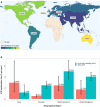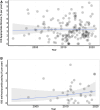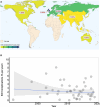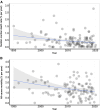Global and Temporal Trends in Utilization and Outcomes of Implantable Cardioverter Defibrillators in Hypertrophic Cardiomyopathy
- PMID: 39895487
- PMCID: PMC11837969
- DOI: 10.1161/CIRCEP.124.013479
Global and Temporal Trends in Utilization and Outcomes of Implantable Cardioverter Defibrillators in Hypertrophic Cardiomyopathy
Abstract
Background: Over the past decades, hypertrophic cardiomyopathy has become a contemporary treatable disease. However, limited data exist on the global trends of implantable cardioverter defibrillator (ICD) utilization and its impact on mortality/morbidity burden reduction.
Methods: Electronic databases were systematically searched up to March 2024 for studies reporting on ICD utilization rates in hypertrophic cardiomyopathy. A random effects model was used to pool study estimates across time-era, geographic region, and age group. Primary outcome was global trends in ICD utilization. Secondary outcomes included trends of sudden cardiac death, appropriate/inappropriate shocks, and ICD-related complications.
Results: In total, 234 studies (N=92 500, 514 748 patient-years) met inclusion criteria. Mean age was 46.2 (12.4) years and 37.49% were women. A total of 12 139 patients (16.43%) received an ICD over 429 766 person-years of follow-up, with an ICD implantation rate of 2.79%/y ([95% CI, 2.35%-3.32%] I²=97.80%). Rates of ICD implantation steadily increased over time from 1990 (1.09%) to 2021 (4.01%; P=0.002), with noticeable geographic variation (P=0.008). The overall rate of appropriate ICD discharges and ICD-related complications was 3.44%/y ([95% CI, 3.08%-3.84%] I²=88.40%) and 1.98%/y ([95% CI, 1.52%-2.59%] I²=90.44%), respectively, with no significant trend over time. The overall rate of inappropriate discharges was 3.58%/y ([95% CI, 3.08%-4.16%] I2=88.03%), and declined significantly over time (P=0.044). There was a significant decline in the rates of sudden cardiac death from 1990 (0.84%/y) to 2020 (0.31%/y).
Conclusions: Dramatic increases in ICD utilization have occurred, representing a 3.7-fold increase, with appropriate therapies occurring in 3.44%/y. In parallel a significant reduction in sudden cardiac death was observed, but there are insufficient data to demonstrate that a causative relationship exists. Geographic disparities in ICD utilization were evident, highlighting the need to improve access to specialized care for patients with hypertrophic cardiomyopathy. Geographic disparities in ICD utilization were evident, highlighting the need to improve access to specialized care for patients with hypertrophic cardiomyopathy.
Registration: URL: https://www.crd.york.ac.uk/PROSPERO/; Unique identifier: CRD42023407126.
Keywords: cardiomyopathy, hypertrophic; death, sudden, cardiac; defibrillators, implantable; morbidity; mortality.
Conflict of interest statement
None.
Figures








Similar articles
-
Temporal and Global Trends of the Incidence of Sudden Cardiac Death in Hypertrophic Cardiomyopathy.JACC Clin Electrophysiol. 2022 Nov;8(11):1417-1427. doi: 10.1016/j.jacep.2022.07.012. Epub 2022 Sep 28. JACC Clin Electrophysiol. 2022. PMID: 36424010
-
Clinical Course and Quality of Life in High-Risk Patients With Hypertrophic Cardiomyopathy and Implantable Cardioverter-Defibrillators.Circ Arrhythm Electrophysiol. 2018 Apr;11(4):e005820. doi: 10.1161/CIRCEP.117.005820. Circ Arrhythm Electrophysiol. 2018. PMID: 29625970
-
Outcome and complications after implantable cardioverter defibrillator therapy in hypertrophic cardiomyopathy: systematic review and meta-analysis.Circ Heart Fail. 2012 Sep 1;5(5):552-9. doi: 10.1161/CIRCHEARTFAILURE.112.969626. Epub 2012 Jul 20. Circ Heart Fail. 2012. PMID: 22821634
-
Implantable cardioverter defibrillators in patients with electrical heart disease and hypertrophic cardiomyopathy: data from the German device registry.Clin Res Cardiol. 2020 Apr;109(4):508-512. doi: 10.1007/s00392-019-01532-9. Epub 2019 Jul 31. Clin Res Cardiol. 2020. PMID: 31367999
-
Implantable cardioverter-defibrillator in patients with hypertrophic cardiomyopathy: efficacy and complications of the therapy in long-term follow-up.J Cardiovasc Electrophysiol. 2010 Aug 1;21(8):883-9. doi: 10.1111/j.1540-8167.2009.01716.x. Epub 2010 Feb 1. J Cardiovasc Electrophysiol. 2010. PMID: 20132378
References
-
- Maron BJ, Desai MY, Nishimura RA, Spirito P, Rakowski H, Towbin JA, Dearani JA, Rowin EJ, Maron MS, Sherrid MV. Management of hypertrophic cardiomyopathy. J Am Coll Cardiol. 2022;79:390–414. doi: 10.1016/j.jacc.2021.11.021 - PubMed
-
- Maron BJ. Clinical course and management of hypertrophic cardiomyopathy. N Engl J Med. 2018;379:655–668. doi: 10.1056/NEJMra1710575 - PubMed
-
- Abdelfattah OM, Martinez M, Sayed A, ElRefaei M, Abushouk AI, Hassan A, Masri A, Winters SL, Kapadia SR, Maron BJ, et al. . Temporal and global trends of the incidence of sudden cardiac death in hypertrophic cardiomyopathy. JACC Clin Electrophysiol. 2022;8:1417–1427. doi: 10.1016/j.jacep.2022.07.012 - PubMed
-
- Maron BJ, Estes NAM, Rowin EJ, Maron MS, Reynolds MR. Development of the implantable cardioverter-defibrillator. J Am Coll Cardiol. 2023;82:353–373. doi: 10.1016/j.jacc.2023.04.056 - PubMed
-
- Dechert BE, Bradley DJ, Serwer GA, Dick Ii M, Lapage MJ. Implantable cardioverter defibrillator outcomes in pediatric and congenital heart disease: time to system revision. Pacing Clin Electrophysiol. 2016;39: 703–708. doi: 10.1111/pace.12878 - PubMed
Publication types
MeSH terms
LinkOut - more resources
Full Text Sources
Medical
Miscellaneous

